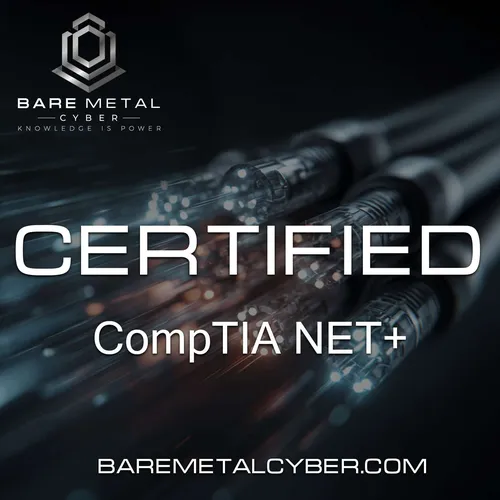
Certified - CompTIA Network + Audio Course
The Network Plus Audio Course is your comprehensive audio training series for mastering the CompTIA Network Plus certification. Designed for learners on the go, this prepcast transforms exam objectives into clear, structured, and engaging episodes tailored for auditory learning. Whether you're walking, commuting, or studying between shifts, each episode breaks down complex networking topics into digestible segments aligned with the official CompTIA blueprint. From OSI layers and IP addressing to wireless standards and troubleshooting methodologies, the series leaves no objective unexplored.
Created by Bare Metal Cyber, a trusted name in cybersecurity education, this prepcast doesn’t just teach — it prepares you for the exam format itself. You’ll learn how to approach multiple-choice questions, understand tricky phrasing, and think like a test writer. Every episode is fully narrated for machine voice clarity, making it perfect for repetition and review. Whether you're a first-time test taker or recertifying, the Network Plus PrepCast helps you build the confidence and competence to pass the exam and succeed in your networking career.
- Update frequency
- every day
- Average duration
- 14 minutes
- Episodes
- 184
- Years Active
- 2025

Episode 84: Security Implications of Cloud Computing
This episode addresses the security implications of cloud computing, focusing on how responsibilities are shared between provider and customer. Topics include data protection, identity and access man…

Episode 83: Elasticity and Scalability — Growing on Demand
This episode explores elasticity and scalability, two defining characteristics of cloud computing. Elasticity refers to the ability to automatically expand or contract resources based on demand, whil…

Episode 82: Multitenancy — Sharing the Cloud Securely
This episode introduces the concept of multitenancy, where multiple customers share the same cloud infrastructure while maintaining logical separation. Hypervisors, containers, and virtual networks e…

Episode 81: Cloud Connectivity — VPN and Private Links
This episode explains how organizations connect securely to cloud environments using Virtual Private Networks (VPNs) and private links. VPNs extend encrypted tunnels over the Internet, providing secu…

Episode 80: Infrastructure as Code — Automating the Cloud
This episode introduces Infrastructure as Code (IaC), the practice of managing and provisioning infrastructure through machine-readable configuration files rather than manual processes. Tools like Te…

Episode 79: Cloud Service Models — SaaS, IaaS, PaaS, and DaaS
This episode covers cloud service models, which define how computing resources are delivered. Software as a Service (SaaS) provides complete applications, Infrastructure as a Service (IaaS) delivers …

Episode 78: Cloud Deployment Models — Public, Private, Hybrid, Community
This episode introduces the four main cloud deployment models: public, private, hybrid, and community. Public clouds provide shared resources over the Internet, private clouds are dedicated to one or…

Episode 77: Storage Area Networks (SANs) — High-Speed Storage Over the Network
This episode explains Storage Area Networks (SANs), specialized networks that provide high-speed access to consolidated storage resources. SANs use protocols like Fibre Channel or iSCSI to deliver bl…

Episode 76: Location Models — Branch Office, On-Prem, and Colocation
This episode introduces network location models, focusing on branch office, on-premises, and colocation deployments. A branch office model connects smaller remote offices back to a central corporate …

Episode 75: Understanding Network Traffic Flow — North-South vs. East-West
This episode explains the concepts of north–south and east–west traffic flow in networks. North–south traffic refers to communication between internal devices and external networks such as the Intern…

Episode 74: Spine-and-Leaf Architecture — Flattening the Network
This episode introduces spine-and-leaf architecture, a design commonly used in modern data centers. In this model, all leaf switches connect to every spine switch, creating a consistent and predictab…

Episode 73: SDN in Operation — The Management Plane Explained
This episode explores how SDN operates in practice, focusing on the management plane. The management plane is where administrators define network policies, monitor performance, and control behavior t…

Episode 72: Software-Defined Networking (SDN) Fundamentals
This episode explains Software-Defined Networking (SDN), which separates the control plane from the data plane to provide centralized management and programmability. Instead of configuring each devic…

Episode 71: Three-Tiered Architecture — Core, Distribution, and Access
This episode introduces the three-tiered network architecture model, which organizes devices into core, distribution, and access layers. The core provides fast, high-capacity forwarding between distr…

Episode 70: Network Time Protocol (NTP) — Keeping Clocks in Sync
This episode explains Network Time Protocol (NTP), which synchronizes clocks across devices to ensure accurate timestamps and coordinated operations. Accurate timekeeping is essential for authenticat…

Episode 69: DNS Essentials — Records, Resolution, and Queries
This episode examines the Domain Name System (DNS), which translates hostnames into IP addresses. It introduces common record types such as A, AAAA, MX, and CNAME, as well as the process of recursive…

Episode 68: DHCP Concepts and Configuration Essentials (Scope, Reservations, Relay)
This episode explores Dynamic Host Configuration Protocol (DHCP), which automatically assigns IP addresses and related configuration details to devices. Concepts such as DHCP scopes, reservations, an…

Episode 67: Connection-Oriented vs. Connectionless — Making Sense of Transport Styles
This episode explains the difference between connection-oriented and connectionless communication, two fundamental transport styles. Connection-oriented communication, as seen with TCP, establishes a…

Episode 66: GRE and IPsec — Tunneling and Secure Transport
This episode introduces two important tunneling and transport technologies: Generic Routing Encapsulation (GRE) and Internet Protocol Security (IPsec). GRE provides a simple way to encapsulate packet…

Episode 65: TCP and UDP — The Transport Layer's Two Engines
This episode focuses on Transmission Control Protocol (TCP) and User Datagram Protocol (UDP), the two primary protocols at the transport layer. TCP is connection-oriented, ensuring reliable delivery …